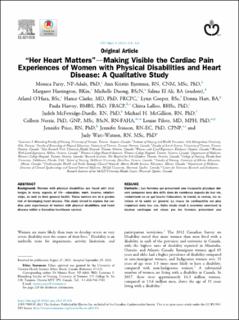| dc.contributor.author | Parry, Monica | |
| dc.contributor.author | Bjørnnes, Ann Kristin | |
| dc.contributor.author | Harrington, Margareth | |
| dc.contributor.author | Duong, Michelle | |
| dc.contributor.author | Salma, El Ali | |
| dc.contributor.author | O`Hara, Arland | |
| dc.contributor.author | Clarke, Hance | |
| dc.contributor.author | Cooper, Lynn | |
| dc.contributor.author | Hart, Donna | |
| dc.contributor.author | Harvey, Paula | |
| dc.contributor.author | Lalloo, Chitra | |
| dc.contributor.author | McFetridge-Durdle, Judith | |
| dc.contributor.author | McGillion, Michael H. | |
| dc.contributor.author | Norris, Colleen | |
| dc.contributor.author | Pilote, Louise | |
| dc.contributor.author | Price, Jennifer | |
| dc.contributor.author | Stinson, Jennifer | |
| dc.contributor.author | Watt-Watson, Judy | |
| dc.coverage.spatial | Canada | en_US |
| dc.date.accessioned | 2022-03-22T08:39:09Z | |
| dc.date.available | 2022-03-22T08:39:09Z | |
| dc.date.created | 2021-11-02T15:42:06Z | |
| dc.date.issued | 2021-02-08 | |
| dc.identifier.issn | 2589-790X | |
| dc.identifier.uri | https://hdl.handle.net/11250/2986697 | |
| dc.description.abstract | Background: Women with physical disabilities are faced with challenges in many aspects of life-education, work, income, relationships, as well as their general health. These women are at a greater risk of developing heart disease. This study aimed to explore the cardiac pain experiences of women with physical disabilities and heart disease within a Canadian healthcare context.
Methods: In this qualitative study, 8 women with physical disabilities and heart disease from across Canada were interviewed. They were asked about their pre-, peri-, and post-diagnostic experiences in the Canadian healthcare system. Transcripts of the interviews were analyzed using a hermeneutic phenomenological approach inspired by Ricoeur.
Results: Two main themes were uncovered in the analysis of the transcripts, as follows: (i) the diagnostic journey; and (ii) life with cardiac symptoms and a disability. The women indicated that they had experienced difficulties in utilizing the Canadian healthcare system prior to receiving a cardiac diagnosis, including long waitlists, expensive and unreliable transport, issues with accessibility, and dealing with providers’ attitudinal barriers regarding disability. Receiving a diagnosis was challenging due to poor relationships with healthcare providers; however, having a same-sex provider seemed essential to receiving adequate care. Self-managing a disability and heart disease had significant physical and psychological impact, which was lightened by financial and social supports, modified lifestyle choices, and self-advocacy.
Conclusions: Women with physical disabilities are often forgotten in discussions encompassing equity and inclusion. The participants’ experiences offer insight into what changes are needed within the Canadian healthcare system in order to improve outcomes for these women. | en_US |
| dc.description.abstract | Contexte: Les femmes qui présentent une incapacité physique doivent composer avec des défis dans de nombreux aspects de leur vie, notamment en ce qui touche l’éducation, le travail, le revenu, les relations et la santé en général. Le risque de cardiopathie est plus important dans leur cas. Cette étude visait à examiner comment la douleur cardiaque est vécue par les femmes présentant une incapacité physique et une cardiopathie dans le contexte des soins de santé au Canada.
Méthodologie: Dans le cadre de cette étude qualitative, huit femmes présentant une incapacité physique et une cardiopathie ont participé à des entrevues menées à l’échelle du Canada. Elles ont été interrogées sur leurs expériences au sein du système de santé canadien au cours des périodes précédant, entourant et suivant le diagnostic. Les transcriptions des entrevues ont été analysées en fonction d’une approche phénoménologique herméneutique inspirée par Ricœur.
Résultats: Deux grands thèmes ressortent de l’analyse des transcriptions, à savoir : (i) le parcours diagnostique; (ii) la vie avec des symptômes cardiaques et une incapacité physique. Les femmes interrogées ont indiqué qu’elles avaient éprouvé des difficultés dans leur parcours au sein du système de santé canadien avant de recevoir un diagnostic en cardiologie, évoquant à cet égard les longues listes d’attente, les services de transport coûteux et peu fiables, les problèmes d’accessibilité et les obstacles liés à l’attitude des fournisseurs de soins vis-à-vis de l’incapacité physique. Le fait de recevoir un diagnostic a été éprouvant en raison de rapports difficiles avec les fournisseurs de soins de santé; cependant, le fait d’avoir un fournisseur de soins de sexe féminin semblait être une condition essentielle à une prestation de soins adéquate. L’autoprise en charge d’une incapacité physique et d’une cardiopathie a eu des répercussions physiques et psychologiques importantes qui ont pu être allégées par le soutien financier et social, des modifications des habitudes de vie et l’autonomie sociale.
Conclusions: Les femmes qui présentent une incapacité physique sont souvent laissées pour compte dans les discussions portant sur l’équité et l’inclusion. Le vécu des participantes donne un aperçu des changements qui doivent être apportés au sein du système de santé canadien afin d’améliorer les résultats chez ces femmes. | en_US |
| dc.description.sponsorship | Funding was received from the Women’s Xchange 15K Challenge, Women’s College Hospital, Toronto, Ontario, Canada. | en_US |
| dc.language.iso | eng | en_US |
| dc.publisher | Elsevier | en_US |
| dc.relation.ispartofseries | CJC Open;Volume 4, Issue 2 | |
| dc.rights | Attribution-NonCommercial-NoDerivatives 4.0 Internasjonal | * |
| dc.rights.uri | http://creativecommons.org/licenses/by-nc-nd/4.0/deed.no | * |
| dc.subject | Physical disabilities | en_US |
| dc.subject | Heart disease | en_US |
| dc.subject | Women’s health | en_US |
| dc.subject | Cardiac pain | en_US |
| dc.title | “Her Heart Matters”, Making Visible the Cardiac Pain Experiences of Women with Physical Disabilities and Heart Disease: A Qualitative Study | en_US |
| dc.type | Journal article | en_US |
| dc.description.version | publishedVersion | en_US |
| dc.rights.holder | © 2021 The Authors | en_US |
| cristin.ispublished | true | |
| cristin.fulltext | postprint | |
| dc.identifier.doi | https://doi.org/10.1016/j.cjco.2021.09.028 | |
| dc.identifier.cristin | 1950688 | |
| dc.source.journal | CJC Open | en_US |
| dc.source.volume | 4 | en_US |
| dc.source.issue | 2 | en_US |
| dc.source.pagenumber | 214-222 | en_US |

